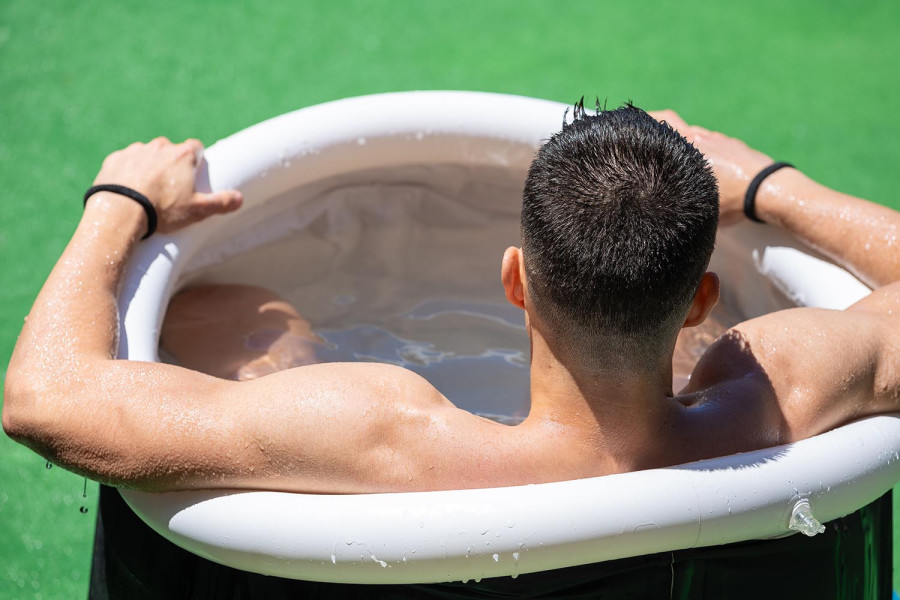Culture & Lifestyle
What cold plunges really do to your body
Once reserved for athletes, cold plunges are now a wellness trend. But are the benefits real—or is it just another icy fad?
Aarya Chand
In recent years, cold plunges—brief immersions in icy water—have surged in popularity. They are praised for benefits ranging from reduced inflammation to mental resilience. But are these claims rooted in science, or just another fleeting fitness trend?
Rohit Chettri, co-founder of House of Grit and a Cult-certified coach specialising in lifestyle, strength, conditioning, and Olympic weightlifting, shares his insights on the rising trend of cold plunges. Currently ranked 8th in CrossFit India’s Men Individuals (2025) division, Chettri discusses both the potential benefits and health risks of cold water immersion, from muscle recovery and mood enhancement to the dangers it may pose for those with underlying health conditions.
What exactly is a cold plunge, and how cold is it really?
A cold plunge is a form of cold water immersion therapy in which individuals submerge themselves in chilled water, typically ranging from 10 to 15 degrees Celsius. The practice usually lasts anywhere from 30 seconds to up to 10 minutes, depending on a person’s tolerance and experience.
Often used for recovery and mental conditioning, the plunge is brief but intense, designed to shock the system and stimulate physiological responses.
How should someone safely approach a cold plunge for the first time? What are the key dos and don’ts?
Diving into a cold plunge isn’t as simple as jumping into icy water. For beginners, a slow and mindful approach is key. Start with shorter durations, around one to two minutes, and gradually build tolerance over time. Staying well-hydrated before and after the plunge is essential, as is maintaining steady, controlled breathing to help the body remain calm under stress. Cold plunges are best incorporated into recovery routines, especially on days when the body feels sluggish or overworked.
However, there are clear boundaries not to cross. Overextending your time in the water can increase the risk of hypothermia, and substances like alcohol or drugs should be strictly avoided before plunging. Frequency matters too—more is not always better. Two to three sessions per week are generally sufficient. Additionally, it’s important to avoid fully submerging the head or immediately jumping into a hot shower afterwards, as both can jolt the body’s system and potentially do more harm than good.
What are the actual, science-backed benefits of cold plunges—for recovery or resilience?
While cold plunges may seem like just another wellness trend, scientific research points to tangible physical and psychological benefits. A study published in Neuroscience Letters found that brief cold exposure at 57°F increased dopamine levels by 250 percent and noradrenaline by 530 percent, two neurochemicals linked to motivation, mood, and mental clarity.
Physically, cold plunges have been shown to reduce muscle inflammation and soreness. A 2023 meta-analysis confirmed that cold water immersion helps lower creatine kinase levels, a marker of muscle damage, and improves “perceived recovery”, a measure that indicates how ready an athlete feels for the next session.
In terms of performance, research on high-intensity athletes found cold plunge users recovered explosive power—like sprinting or jumping—more effectively within 24 hours. However, strength and endurance gains remained unchanged.
Beyond the gym, a Dutch study of over 3,000 participants found that those who ended warm showers with 30 to 90 seconds of cold water took 29 percent fewer sick days than those who didn’t.
In short, when done right, cold plunges appear to offer real recovery benefits, not just viral appeal.

What are its health risks, especially for those with heart or blood pressure issues?
While cold plunges offer recovery benefits for many, they aren’t without risks, especially for individuals with underlying health conditions. The sudden exposure to cold water can trigger what’s known as ‘Cold Water Immersion Syndrome’ or ‘Cold Shock Response’, leading to a rapid spike in heart rate and blood pressure. For those with cardiovascular issues, this can result in serious complications such as arrhythmia, heart attack, or even stroke.
The physiological stress doesn’t stop there. Cold exposure can cause a dangerous shift in body fluids, potentially impacting lung function and increasing the risk of heart failure in vulnerable individuals. Breathing difficulties and hypothermia are also real concerns if a plunge is done unsafely or for too long.
I strongly advise anyone with heart disease, high blood pressure, or respiratory issues to consult a doctor before incorporating cold plunges into their routine. What’s marketed as a wellness ritual on social media can quickly become hazardous if approached without medical awareness.
Who should and shouldn’t be taking the plunge?
Cold plunges can offer a range of benefits, particularly for healthy individuals without underlying medical conditions. Regular exposure to cold water has been linked to reduced muscle soreness, improved recovery, and even lower stress levels. For athletes and active individuals, it can be a valuable tool in the recovery toolkit.
However, cold immersion isn’t for everyone. Those with cardiovascular conditions or other serious health concerns should steer clear—or at the very least, consult a medical professional before giving it a try. The sudden shock of cold water can place extra strain on the heart and nervous system, making it potentially dangerous for those with preexisting conditions.
Why have cold plunges gone viral—genuine recovery or just social media hype?
The recent surge in cold plunge popularity can be traced back to athletes and wellness influencers who’ve embraced the practice and promoted it across platforms. While some of the buzz may be driven by social media aesthetics, there is scientific backing to the trend. Studies suggest that cold water immersion can aid in muscle recovery and even support overall performance, making it more than just an internet fad.




 13.84°C Kathmandu
13.84°C Kathmandu















